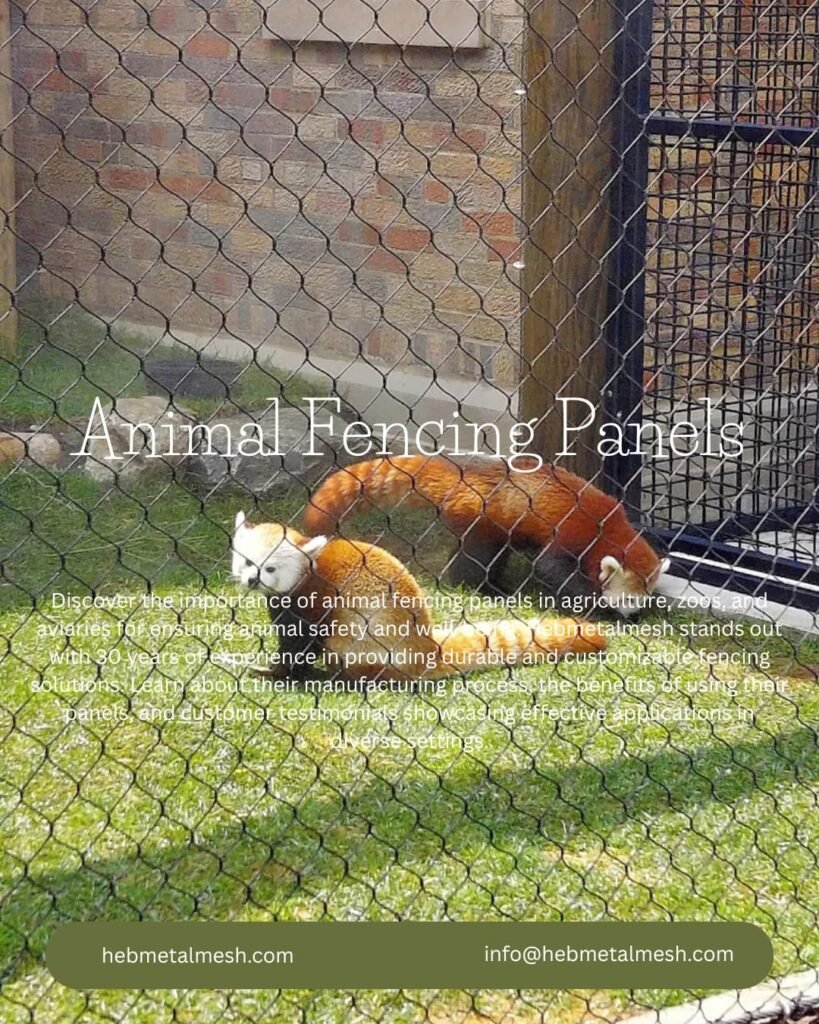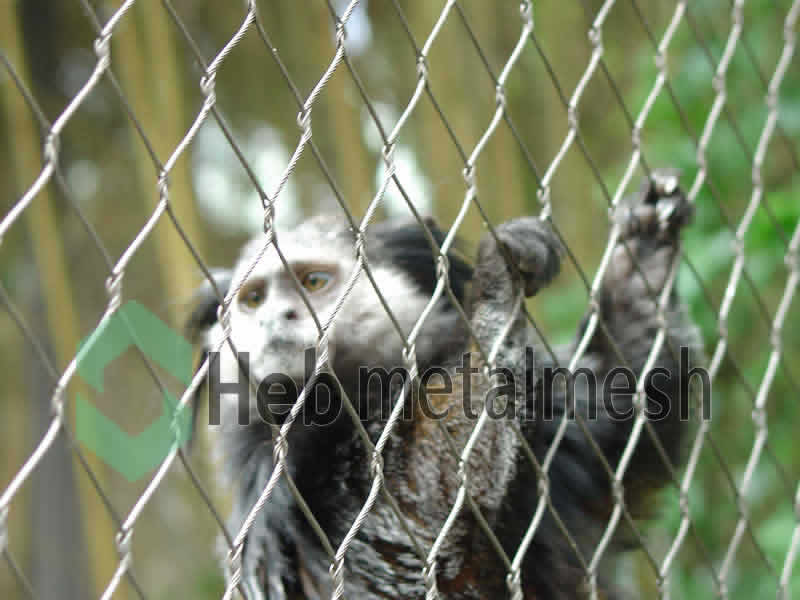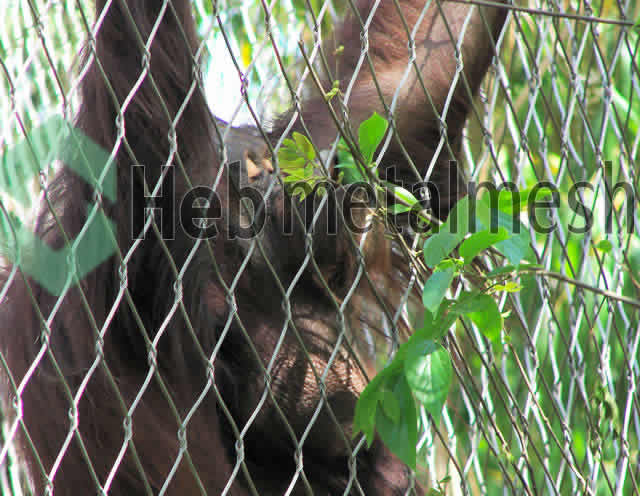Introduction
At the heart of every great zoo, wildlife park, or private conservancy lies a profound, dual challenge: how do you safely and reliably contain animals, often powerful or agile creatures, while simultaneously maximizing their well-being and providing an unforgettable visitor experience? It’s a delicate balance between security and seamless naturalism. This challenge is precisely where animal fence netting steps in. Far from being a simple wire barrier, this netting is a critical, often underestimated, component in modern zoo enclosure design, aviaries, agricultural settings, and even large-scale private enclosures.
The netting you choose dictates everything from animal safety and habitat health to long-term operational costs. Selecting the wrong material can lead to costly maintenance, compromised security, and potential injury to the animals. This comprehensive guide will delve into the various types, applications, and critical factors to consider when choosing the right animal containment fencing, culminating in an exploration of the industry gold standard for safety, aesthetics, and longevity.
Section 1: Understanding the Diverse World of Animal Fence Netting
Topic Sentence: Not all animal fence netting is created equal; the right choice depends entirely on the species being contained and the specific environment. Modern enclosures require materials engineered to handle everything from aggressive chewing to extreme humidity.
Sub-section 1.1: By Material
The material dictates the durability, strength, and life span of the enclosure, influencing its suitability as long-lasting enclosure netting.
- Plastic/Polyethylene: This is the lowest-cost and most lightweight option, often used for temporary barriers, light avian netting, or non-critical agricultural applications. Its low durability and susceptibility to UV damage and chewing make it unsuitable for containing any medium to large animals.
- Galvanized Steel: Stronger than plastic, this moderate-cost option is popular for general-purpose fencing. However, the galvanization process only provides surface protection, making it susceptible to rust once the coating is scratched or exposed to prolonged moisture. Its short lifespan limits its use as a truly long-lasting enclosure netting in professional settings.
- Stainless Steel: The professional choice. Offering the highest strength-to-weight ratio, maximum durability, and superior inherent corrosion-resistant animal fencing, stainless steel is the preferred material for zoos and high-security wildlife enclosure mesh. Its resilience sets the stage for its superiority.
Sub-section 1.2: By Application
Different animals require fundamentally different types of mesh, demanding specialized solutions:
- Wildlife Enclosure Mesh: Used for large mammals and primates (e.g., big cats, bears, and gorillas). This requires significant tensile strength and is often referred to as heavy-duty zoo mesh.
- Avian Netting: Specialized, fine mesh crucial for bird sanctuaries and large free-flight aviaries. The focus here is on visibility and preventing flight escape while protecting birds from external predators.
- Aquatic Animal Barriers: Mesh used around pools, exhibits, or water features. This application demands exceptional resistance to constant moisture and salt, putting maximum pressure on corrosion-resistant animal fencing.
- Agricultural and Livestock Fencing: Options for containing farm animals that prioritize a cost-effective, yet durable animal fence structure for open pasture settings.
Section 2: Key Considerations When Choosing Your Animal Containment Fencing
Topic Sentence: Selecting the perfect mesh is a critical balancing act between ensuring animal safety, guaranteeing structural integrity, and optimizing long-term value, which ultimately determines if you’ve installed truly safe animal barriers.
Sub-section 2.1: Animal-Specific Factors
The mesh must be chosen based on the precise physical and behavioral needs of the species.
- Containment Needs: This involves two primary considerations: strength and aperture size. For large, powerful animals like bears or lions, the mesh must be heavy-duty zoo mesh capable of resisting thousands of pounds of force. Conversely, for smaller primates or rodents, a precise mesh aperture is necessary to prevent entrapment or, worse, escape.
- Behavioral Considerations: The material must be resilient to specific animal behaviors. Is the species known for chewing, biting, or scratching? Does the animal climb? If so, the mesh must function as a reliable climbing animal fence—strong enough to support the animal’s weight without sagging or breaking, yet flexible enough to form complex 3D structures.
- Safety and Welfare: Above all, the material must contribute to enriching the mesh for animal habitats. This means using non-toxic materials with a smooth, burr-free finish to prevent cuts, abrasions, or chemical exposure if animals mouth or chew on it.
Sub-section 2.2: Environmental and Durability Factors
A mesh that fails due to environmental factors is a security risk. Longevity is paramount in animal park fencing.
- Corrosion Resistance: This is arguably the most critical long-term factor. In environments like humid aviaries, coastal zoos, or near water features, standard steel will quickly degrade. The need for truly corrosion-resistant animal fencing becomes an absolute necessity to prevent catastrophic failure and ensure the enclosure remains a long-lasting enclosure netting system.
- Weather Resistance: The mesh must be able to withstand the full spectrum of climatic conditions—from intense UV radiation (which degrades plastics) to extreme temperatures and moisture. It must maintain its tensile strength and integrity over decades without noticeable degradation.
- Strength and Flexibility: A quality material must be strong enough to withstand brute force without breaking, yet possess enough give to absorb the kinetic energy of an impact (such as a running animal hitting the barrier). This dynamic flexibility is the hallmark of a durable animal fence designed for safety.
Section 3: The Gold Standard: Why Stainless Steel Zoo Mesh is the Superior Choice
Topic Sentence: For professionals who cannot compromise on safety, security, or aesthetics, stainless steel zoo mesh stands alone as the premier solution, meeting the highest standards of modern animal park fencing.
Sub-section 3.1: Unmatched Durability and Longevity
The inherent properties of high-grade stainless steel (specifically the 304 and 316 marine grades) provide an unparalleled defense against environmental breakdown.
Unlike galvanized steel, the corrosion resistance is not merely a surface coating; it’s intrinsic to the alloy. This makes it impervious to rust, general corrosion, and the devastating effects of UV radiation. This superior durability minimizes maintenance requirements and guarantees a significantly long lifecycle, often measured in decades, which provides a far better Return on Investment (ROI) despite a higher initial cost. It is the definition of long-lasting enclosure netting.
Sub-section 3.2: Superior Safety for Animals and Keepers
The specialized manufacturing process—often hand-woven or ferrule-knotted—produces a wire rope mesh with an incredibly smooth, burr-free finish. This detail is essential for preventing cuts, abrasions, and snagging, ensuring the mesh provides safe animal barriers. Furthermore, stainless steel is non-toxic and inert, meaning there is no risk of chemical leaching or poisoning, even if intelligent or curious animals repeatedly mouth or chew on the material.
Sub-section 3.3: Aesthetic and Functional Benefits
Modern zoo enclosure design seeks to eliminate visual barriers between visitors and animals. Stainless steel cable mesh is uniquely suited to this goal:
- Unobtrusive Views: The cable mesh system’s open, fine, and lightweight design is nearly transparent when viewed from a distance, creating almost invisible barriers. This significantly enhances the visitor experience and improves photography opportunities, making the mesh for animal habitats a feature, not an obstruction.
- Environmental Enrichment: The mesh allows for optimal passage of light, air, and rain, contributing to a more naturalistic, healthy, and comfortable environment for the animals.
- Customizability: The inherent flexibility of the wire rope allows for incredible ease in creating custom mesh sizing and complex, three-dimensional enclosure forms, allowing designers to build unique architectural structures that suit specific terrains and animal needs.
Section 4: Introducing the Hebmetalmesh Solution: Professional-Grade Stainless Steel Mesh
Topic Sentence: At Hebmetalmesh, we have dedicated our expertise to manufacturing the very stainless steel zoo mesh that sets the global standard for modern, secure animal enclosures.
Our mission goes beyond just selling wire; we partner with architects, engineers, and zoo professionals worldwide to execute successful zoo enclosure design and animal park fencing projects. Hebmetalmesh’s commitment to quality, precision engineering, and deep understanding of unique species-specific needs ensures we provide reliable safe animal barriers.
Highlight key product features:
- Marine-Grade Corrosion Resistance: Our mesh is made from high-grade stainless steel (often Type 316), providing maximum corrosion resistance—a necessity for installations exposed to harsh, humid, or salt-laden air.
- Versatile Custom Mesh Sizing: We understand that every enclosure is unique. Our products are available in a wide range of wire diameters and aperture sizes, allowing for precise custom mesh sizing to safely contain everything from the smallest birds to the most powerful predators.
- Precision Fabrication: Every piece of mesh is fabricated with the utmost precision. Whether using our ferrule-knotted or hand-woven construction, we ensure every connection is secure, durable, and that every surface remains safe and smooth.
- Emphasis on Comprehensive Support: We provide more than just the netting; we offer guidance on attachment systems, load calculations, and long-term maintenance. These comprehensive Hebmetalmesh solutions ensure your investment is protected.
Transition: Our Hebmetalmesh solutions are not just products; they are partnerships in building better, more secure, and more enduring mesh for animal habitats globally.
Section 5: Real-World Applications of Hebmetalmesh Stainless Steel Zoo Mesh
Topic Sentence: From iconic zoos to private conservancies, our mesh provides reliable animal containment fencing across the globe, showcasing its versatility and strength.
- Application 1: Primate Enclosures: The flexible yet strong construction is perfect for creating stimulating 3D environments. It excels as a climbing animal fence, allowing agile primates to use the overhead surfaces and vertical walls for movement and play, while preventing escape.
- Application 2: Large Aviaries and Bird Shows: Our fine wire cable mesh provides the perfect lightweight Avian Netting structure. It offers an open, safe sky for birds without the visual interruption of heavier materials, making the enclosure look vast and unobtrusive.
- Application 3: Big Cat and Bear Habitats: This is where the strength of heavy-duty zoo mesh is paramount. Our product is capable of withstanding immense force and impact from powerful predators, offering keepers and managers peace of mind through a robust and reliable system.
- Application 4: Reptile Houses and Aquatic Features: The superior corrosion-resistant animal fencing properties make it ideal for creating secure, humidity-resistant barriers that maintain their integrity in challenging, moist environments like greenhouses or crocodile habitats.
Section 6: A Practical Guide to Sourcing and Installing Your Animal Fence Netting
Topic Sentence: A successful animal fence netting project starts with careful planning and partnering with the right manufacturer to ensure a safe animal barrier is installed correctly from day one.
- Step 1: Consult with Experts: The complexity of load bearing, tension, and animal behavior requires specialized knowledge. We strongly emphasize the importance of working with experienced engineers and suppliers like Hebmetalmesh early in the process. We can help tailor the perfect custom mesh sizing and wire diameter for your zoo enclosure design.
- Step 2: Focus on Quality Hardware: The mesh itself is only as strong as its attachment points. For a truly durable animal fence, quality stainless steel cables, clamps, ferrules, and support posts are non-negotiable. Cutting corners on hardware is the fastest way to compromise the entire animal containment fencing system.
- Step 3: Professional Installation: Due to the tensioning and load requirements, we highly recommend using trained, professional installers. They ensure the system performs as designed, guaranteeing the longevity and the ultimate safety of the long-lasting enclosure netting.
Conclusion
Choosing the right animal fence netting is one of the most critical, long-term decisions impacting animal safety, welfare, visitor experience, and institutional budget. The subtle differences between materials—the corrosion resistance, the tensile strength, and the aesthetic impact—are what separate a temporary fix from a permanent, professional solution.
For those seeking a permanent, safe, and visually superior solution that blends seamlessly into the habitat, stainless steel zoo mesh is the definitive answer, representing the best value for a long-lasting enclosure netting system over its entire lifecycle.
Ready to build an enclosure that stands the test of time and meets the highest safety standards? Contact Hebmetalmesh today to discuss your project requirements and discover how our professional-grade stainless steel zoo mesh can provide the perfect solution for your animal containment needs.
FAQs: Animal Fence Netting
Stainless steel zoo mesh is the most durable option. It provides superior strength and acts as excellent corrosion-resistant animal fencing, lasting for decades with minimal maintenance, even in harsh weather conditions.
Select a mesh size that prevents animal entrapment and escape. For containing small species or creating a secure avian netting system, a smaller mesh is crucial. Always consider the smallest animal in the enclosure.
Yes. High-quality stainless steel zoo mesh is designed as a safe animal barrier with a smooth, burr-free finish. This prevents injuries, making it safe for everything from delicate birds to powerful climbing animals.
Absolutely. Reputable suppliers like Hebmetalmesh specialize in custom mesh sizing for enclosures. This ensures a perfect fit for any architectural design, providing both security and an unobstructed view for visitors.
While the initial investment is higher, its longevity makes it cost-effective. Heavy-duty zoo mesh resists rust and damage, eliminating frequent replacement costs and providing a superior lifetime value for your animal containment fencing.


